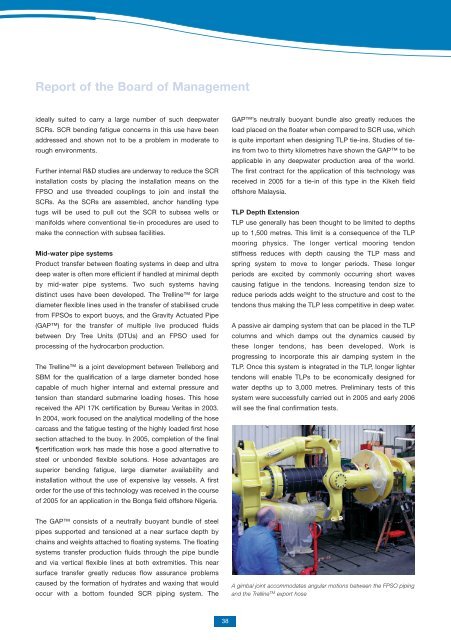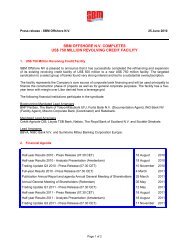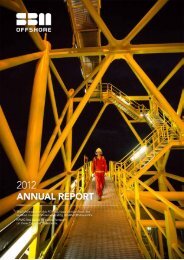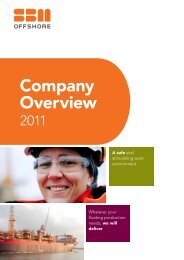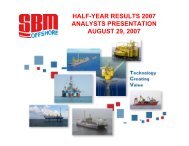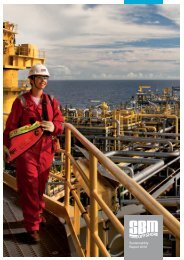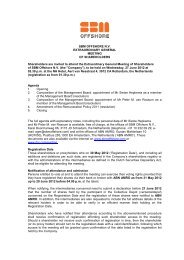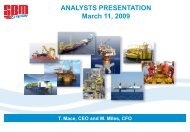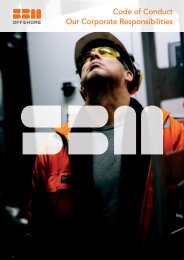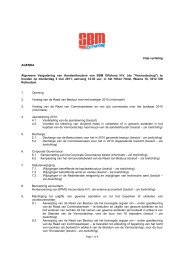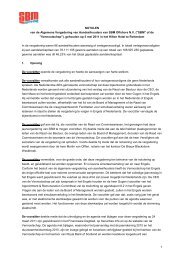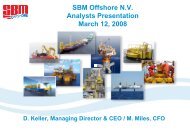2005 Annual Report - SBM Offshore
2005 Annual Report - SBM Offshore
2005 Annual Report - SBM Offshore
You also want an ePaper? Increase the reach of your titles
YUMPU automatically turns print PDFs into web optimized ePapers that Google loves.
<strong>Report</strong> of the Board of Management<br />
ideally suited to carry a large number of such deepwater<br />
SCRs. SCR bending fatigue concerns in this use have been<br />
addressed and shown not to be a problem in moderate to<br />
rough environments.<br />
Further internal R&D studies are underway to reduce the SCR<br />
installation costs by placing the installation means on the<br />
FPSO and use threaded couplings to join and install the<br />
SCRs. As the SCRs are assembled, anchor handling type<br />
tugs will be used to pull out the SCR to subsea wells or<br />
manifolds where conventional tie-in procedures are used to<br />
make the connection with subsea facilities.<br />
Mid-water pipe systems<br />
Product transfer between floating systems in deep and ultra<br />
deep water is often more efficient if handled at minimal depth<br />
by mid-water pipe systems. Two such systems having<br />
distinct uses have been developed. The Trelline for large<br />
diameter flexible lines used in the transfer of stabilised crude<br />
from FPSOs to export buoys, and the Gravity Actuated Pipe<br />
(GAP) for the transfer of multiple live produced fluids<br />
between Dry Tree Units (DTUs) and an FPSO used for<br />
processing of the hydrocarbon production.<br />
The Trelline is a joint development between Trelleborg and<br />
<strong>SBM</strong> for the qualification of a large diameter bonded hose<br />
capable of much higher internal and external pressure and<br />
tension than standard submarine loading hoses. This hose<br />
received the API 17K certification by Bureau Veritas in 2003.<br />
In 2004, work focused on the analytical modelling of the hose<br />
carcass and the fatigue testing of the highly loaded first hose<br />
section attached to the buoy. In <strong>2005</strong>, completion of the final<br />
certification work has made this hose a good alternative to<br />
steel or unbonded flexible solutions. Hose advantages are<br />
superior bending fatigue, large diameter availability and<br />
installation without the use of expensive lay vessels. A first<br />
order for the use of this technology was received in the course<br />
of <strong>2005</strong> for an application in the Bonga field offshore Nigeria.<br />
The GAP consists of a neutrally buoyant bundle of steel<br />
pipes supported and tensioned at a near surface depth by<br />
chains and weights attached to floating systems. The floating<br />
systems transfer production fluids through the pipe bundle<br />
and via vertical flexible lines at both extremities. This near<br />
surface transfer greatly reduces flow assurance problems<br />
caused by the formation of hydrates and waxing that would<br />
occur with a bottom founded SCR piping system. The<br />
38<br />
GAP’s neutrally buoyant bundle also greatly reduces the<br />
load placed on the floater when compared to SCR use, which<br />
is quite important when designing TLP tie-ins. Studies of tieins<br />
from two to thirty kilometres have shown the GAP to be<br />
applicable in any deepwater production area of the world.<br />
The first contract for the application of this technology was<br />
received in <strong>2005</strong> for a tie-in of this type in the Kikeh field<br />
offshore Malaysia.<br />
TLP Depth Extension<br />
TLP use generally has been thought to be limited to depths<br />
up to 1,500 metres. This limit is a consequence of the TLP<br />
mooring physics. The longer vertical mooring tendon<br />
stiffness reduces with depth causing the TLP mass and<br />
spring system to move to longer periods. These longer<br />
periods are excited by commonly occurring short waves<br />
causing fatigue in the tendons. Increasing tendon size to<br />
reduce periods adds weight to the structure and cost to the<br />
tendons thus making the TLP less competitive in deep water.<br />
A passive air damping system that can be placed in the TLP<br />
columns and which damps out the dynamics caused by<br />
these longer tendons, has been developed. Work is<br />
progressing to incorporate this air damping system in the<br />
TLP. Once this system is integrated in the TLP, longer lighter<br />
tendons will enable TLPs to be economically designed for<br />
water depths up to 3,000 metres. Preliminary tests of this<br />
system were successfully carried out in <strong>2005</strong> and early 2006<br />
will see the final confirmation tests.<br />
A gimbal joint accommodates angular motions between the FPSO piping<br />
and the Trelline TM export hose


